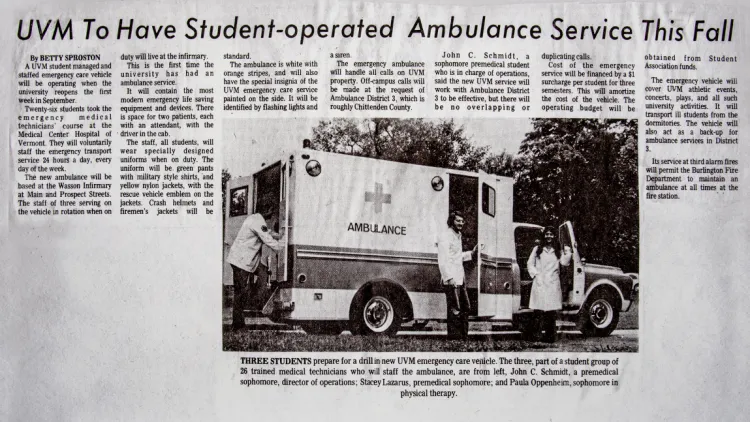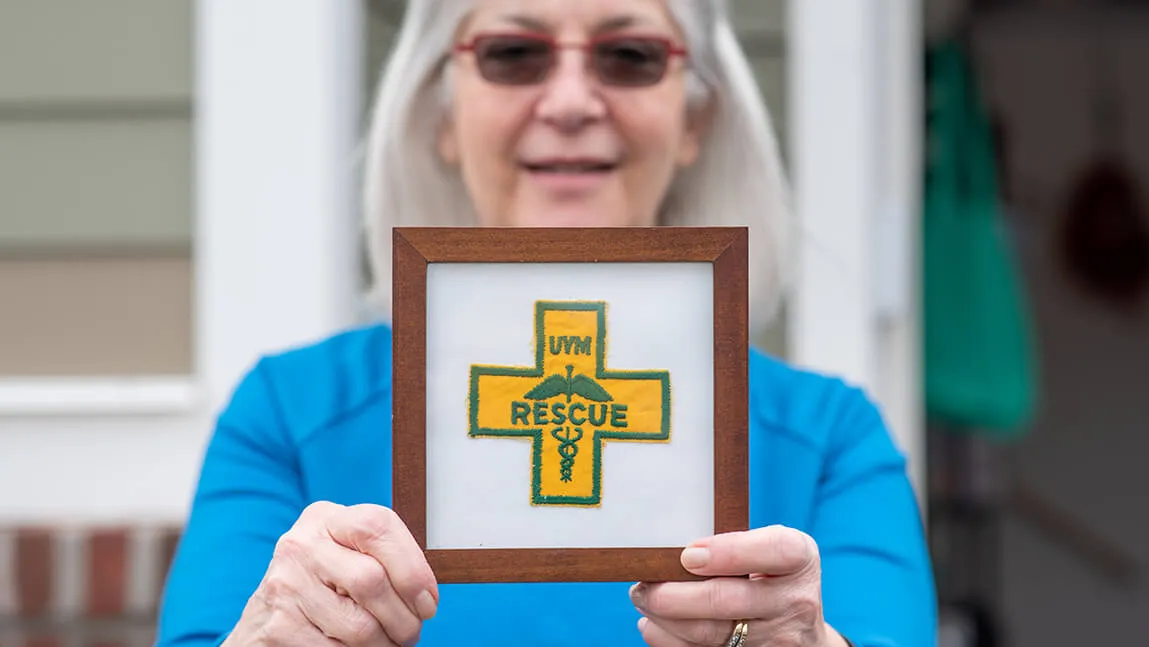When Paula Oppenheim ’75 (now Paula Cope) arrived on the UVM campus, from New York City, in the fall of 1971, she was sixteen years old. Her father had died suddenly the year before and “my mother was an addict with lots of mental health issues,” Cope recalls. “She told me, ‘I’m just not into this mother thing, so have a good life.’ And I never saw her again.” Cope became an emancipated minor and “I hid in the dorms during Christmas break because I had no home,” she said.
But that didn’t stop Cope—during her first year of college—from taking a full load of courses, starting the first ROTC program for women on campus, “falling totally in love with Vermont and UVM,” she said—and co-founding a student-led ambulance corps, UVM Rescue.
On Saturday, April 23, 2022, she and nearly a dozen of the other original members of UVM Rescue joined generations of former Rescue squads—and many current student members—in celebrating the organization’s fiftieth anniversary at a banquet to be held at the Hilton Hotel in downtown Burlington.
To celebrate the milestone, Vermont Governor Phil Scott issued a proclamation declaring Monday, April 25, 2022, "UVM Rescue Day."
“A half-century has gone by and it’s still inspirational,” says Cope, who now lives in Williston, Vt., and runs a management consulting business. “When I see UVM Rescue on the road, going to a call, and I see those students at the wheel, I feel proud. When I see them at an accident, I breathe a sigh of relief. I know that people are being taken care of well.”
Cope gives her classmate (and then-boyfriend) John “Jack” Schmidt ‘75 all the credit for the idea. “We were eating in the Waterman Cafeteria—it doesn’t exist anymore—and he showed up at dinner with a whole bunch of catalogs for all the equipment you need for an ambulance. He threw them down on the table and he’s, like, ‘we gotta start a rescue squad.’”
Cope wasn’t sure. “Do we need this?” she wondered. But during that time, several arson fires tore through Burlington, “taking down the Cathedral of St Paul's, the Catholic cathedral, the Mayfair Store on Church Street, one of the theaters. They were huge fires,” Cope recalls. “We felt like Burlington Rescue was alone—and UVM students, we could help.”
Many local communities near Burlington didn’t have rescue services in those days and relied on funeral homes to transport sick and injured people to the hospital—plus UVM’s student body was getting bigger. “I said, ‘I'm in. We can serve a lot of these towns and on campus,’” Cope says. “Let’s figure this out.”
Cope, Schmidt, and their friend, Stacey Lazarus ’75, soon were taking some of the very first EMT classes offered in Vermont, talking with the doctor in charge of the UVM infirmary, and making a case to the university’s leadership for buying an ambulance. “We thought, for sure, they would just say, ‘you freshmen, like, you silly kids?’ But they took us seriously,” Cope says.
In July 1972, after months of planning, gathering teams of students to get trained, and securing a budget, “we picked up the new truck,” Cope says. “Jack drove, I was in the back, Stacey was in the passenger seat; it was a crazy feeling. We went down Shelburne Road, running the lights, testing the siren. We wore white lab coats because we didn’t know what our uniform was going to be.”

Paula Cope has a framed copy of this newspaper clipping, from August 16, 1972, announcing that "this is the first time the university has had an ambulance service." Cope stands at the door of the ambulance.
A few days later, they got their first emergency call. “It was another big fire. It was terrifying. We were still in our lab coats and we had absolutely no equipment in our truck at all—like not even a Bandaid. But we had a license to transport,” Cope recalls. “One of the firefighters said, ‘bring this guy to the hospital.’ And they threw open the back doors, we pulled out our gurney, strapped this guy in, and we did lights and sirens up to the hospital. Burlington firefighters and rescue guys took us seriously—and that was a big thing. We knew we had a lot to learn, but they saw us as part of the team.”
UVM Rescue was launched that fall semester of 1972—a 100%-student-led ambulance service, staffed 24-hours-a-day, 7-days-a-week, year-round—“for fifty years,” Cope says. Jack Schmidt was the first director of operations, Stacey Lazarus was the first training officer—and Paula Cope was the first personnel officer and first woman on UVM Rescue.
The ambulance was stored in the barn behind Wheeler House, at the time the Wasson Infirmary, near the corner of Prospect and Main Street. When an emergency call would come in, “we’d jump into combat boots, with zippers in them, and run down the icy stairs from the infirmary,” Stacey Lazarus recalls. “You had to have wheels out of the garage in under a minute.”
Cope is like generations of students who join UVM Rescue when she says, “It changed me. It gave me a place because I didn't have a place in my life at that time. It gave me a constant set of friends I could rely on and that I knew needed to rely on me, every shift, every day, with every call. You have to work together, you have to rely on each other.”

Paula Cope survived a traumatic childhood—and directed her teenager energy to helping other people. “My grandmother was a huge influence on me,” Cope says. “She said ‘if you see something that could make a situation better, could help another human, then help. Don’t just walk by and think someone else is going to make it better. You are.’ And that’s why I—we—started UVM Rescue.”
Fifty years later, UVM Rescue is thriving, still helping people—sometimes on the worst day of their life—providing professional assistance, being the humans who show up.
Here's a look at today’s UVM Rescue:
